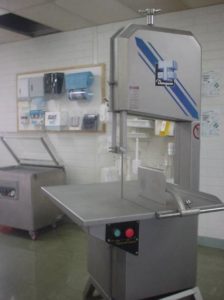How do workers operate equipment safely?
Workers are legally required to work safely and protect others from injury. This includes operating equipment safely. The safe operation of plant includes:
- participating in training in operation of the plant to gain competency
- following work instructions and any other workplace procedures related to the operation of plant
- reporting any issues related to plant to your supervisor
- participating in consultation on the plant you operate
- Following emergency procedures related to plant.
What are some of the safety controls on plant?
The WHS Regulations refer to some of the specific safety controls on plant. These include machine guards and emergency stops.
Machine guards
A guard is a physical or other barrier that can perform several functions including:
- preventing contact with moving parts or controlling access to dangerous areas of plant
- screening harmful emissions such as radiation
- minimising noise through the application of sound-absorbing materials, and
- preventing ejected parts or off-cuts from striking people.
Plant and/or components of plant that require guarding include:
Type A Non-operational plant/components of plant which transmit power and motion:
- belts and pulleys (e.g. refrigeration rooms)
- gear wheels (e.g. chain drive mechanisms)
- shafts and spindles (e.g. viscera tables and conveyor belts)
- flywheels (e.g. motors, etc.)
- slides and cams
- chain and sprocket gears (e.g. conveyor belts).
Type B Operation parts/components of plant:
- tools and dies of power presses
- blades of guillotines (e.g. head splitters)
- circular saw (e.g. horn removal saws)
- band saws (e.g. carcase splitting saw, boning room band saws)
- drills and chucks (e.g. maintenance section, core sampling of frozen cartons)
- elevating platforms (e.g. kill floors).

Bandsaw with guard
© MINTRAC
Permanently fixed physical barriers provide the highest level of protection against hazards. They provide permanent non-moving guards that cannot be removed without the use of tools. This is practical when access is not necessary during the operation, maintenance and cleaning of equipment and prevents access to the moving parts of the machine.
Interlock physical barriers are linked to the operation so that the machine will not operate until the guard is fully closed. They can be electrical, mechanical, pneumatic or hydraulic. This is practical when access is necessary during operation, maintenance and cleaning.
Physical barriers may be either fixed enclosing guards, which prevent access to a particular part of a machine, or fixed distance guards which reduce the possibility of access to any dangerous part or area by their size and ability to keep all parts of the operator at a distance from the hazard.
Presence sensing systems, also known as photoelectric guards, are presence sensing or proximity sensing guards. They have a proximity reaction, i.e. the machine can be deactivated when someone enters or interrupts the barrier. The barriers may include electro-optic action (light barriers, light curtains, light screens) and ultra sonic and protective devices such as pressure mats. These devices may protect the operator from objects ejected from the machine.
Emergency stops
Emergency stop buttons are designed to stop driven machinery or equipment in a situation when a person’s health is at risk. Emergency stop devices should not be the only method of controlling risks. They should be designed as a back-up to other control measures.
What is the general should you do in a plant/machinery emergency?
In an emergency the following steps should be taken:
- The first priority is to engage the emergency stop system, e.g. emergency stop button and, if possible, isolate the power to the plant and equipment
- make sure that other people in the area are protected
- alert others, primarily your supervisor and the first aid officer (if required)
- respond in accordance with your workplace procedures to any injuries that may have occurred (as a worker this generally means that you alert your supervisor and/or first aid officer).
What should you do when cleaning and servicing plant?
Cleaning and servicing equipment may be dangerous. You should only undertake cleaning and servicing of plant if you are fully trained and authorised to do so. You should always follow work instructions related to cleaning and servicing of plant. Particular attention should be paid to the isolation and tagging procedures of the particular machine.
In order to protect the person cleaning and servicing the machinery it is important to make sure the machinery cannot be started when cleaning and servicing is taking place. To achieve this the machinery must be locked out and tagged out (LOTO), and power isolated at the source before cleaning or servicing begins.
If the machinery was operating during the cleaning or servicing the operator might fall into the machinery, body parts may be caught in machinery and articles of clothing or cleaning or servicing equipment may be dragged into the machinery. If the machine is not locked out, then another person may inadvertently turn the machinery on while the operator is cleaning or servicing the machinery.
